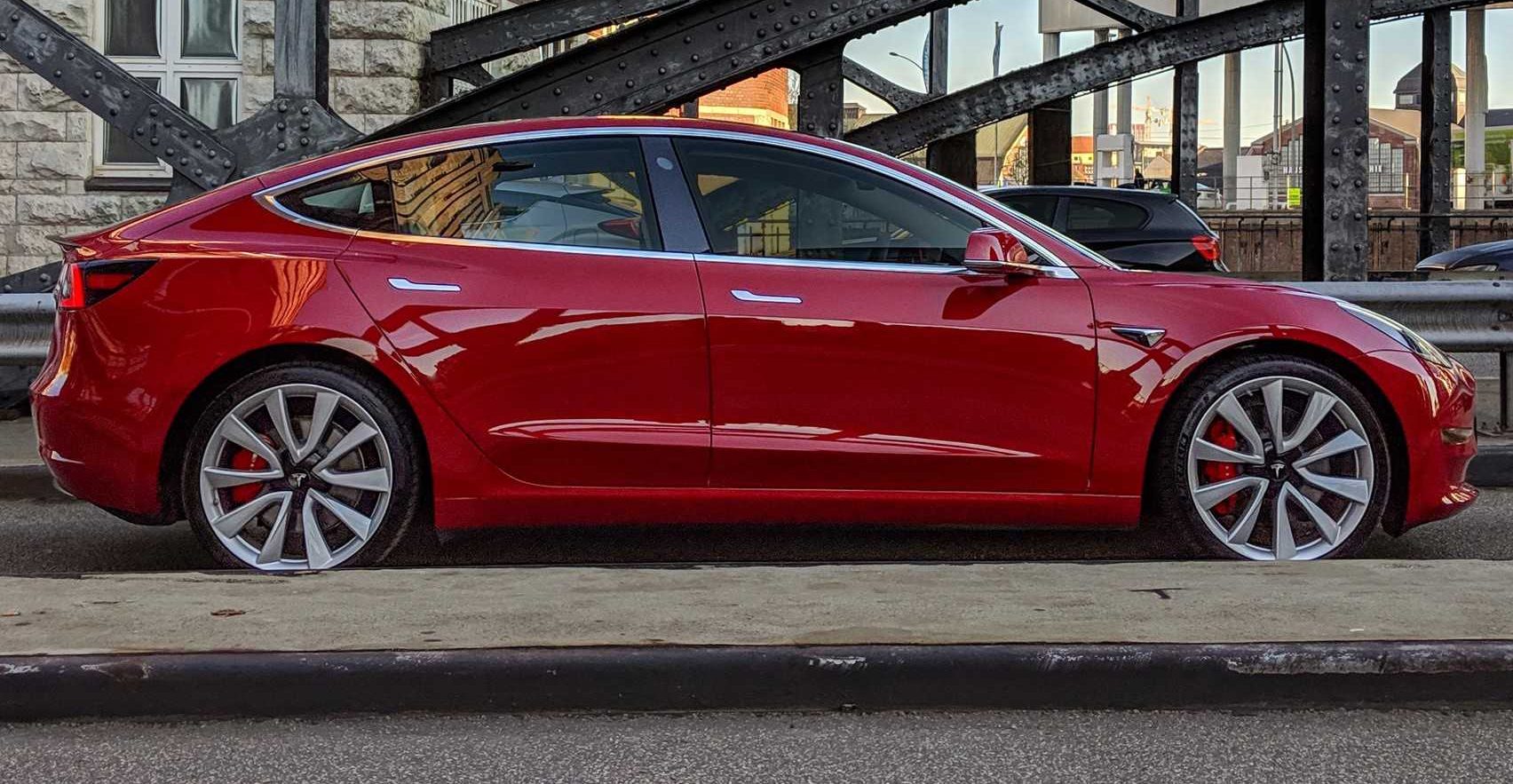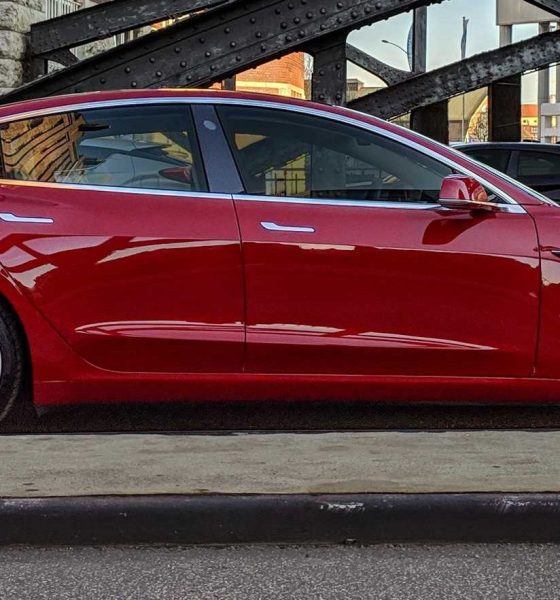

News
Tesla’s pooling deal with Fiat-Chrysler is proving to be a killer combo in Europe
New data from the International Council on Clean Transportation (ICCT) shows that the pooling deal between Tesla and Fiat-Chrysler Automobiles is proving to be a strong force, as the two companies recently made up for 39% of the total electric vehicles registered in Europe.
According to the ICCT, the FCA-Tesla duo made up for nearly 2 of every five electric vehicles sold in Europe during the first quarter of 2020. The next closest competitor was Volvo, which shared 22% of the market with their electric cars. BMW was third with 14%.
“This is the result of a strong uptake of Tesla battery-electric vehicle sales, with a tenfold increase in deliveries in markets such as the UK, while at the same time sales of the Fiat brand combustion engine vehicles were cut in half compared to the previous month,” an ICCT Fact Sheet said.
⚡️Unprecedented⚡️ EV sales🚗all across European car markets in Q1 2020:
📈Record 10% marketshare in March
🇪🇺Driven by EU car CO2 regulation that kicked in on 1 Jan 2020See @TheICCT @MockPeter analysis:https://t.co/eYe8UrfngZ pic.twitter.com/fi7Q2FMcbe
— T&E (@transenv) April 29, 2020
In April 2019, Tesla and Fiat-Chrysler struck a deal to “pool” together their fleets to meet tough European Union emissions standards. The EU allowed company “pooling” to reach the goal of 95g of CO2 per kilometer at the beginning of 2020, and FCA chose Tesla to help accomplish that feat. Fiat Chrysler will pay Tesla around 1.8 billion euros for the deal, which will help them avoid large fines for having excessive emissions rates.
Fiat-Chrysler has plans to transition some of its most popular vehicles to electric as emissions standards are proving to be a tough task for the company when it is standing alone. The Fiat 500e will roll out for its first deliveries in Europe in July 2020. Meanwhile, the company also has plans to electrify the Fiat Panda, a car that could launch as soon as 2021.
Furthermore, FCA also expressed intentions to build Plug-In Hybrid variants of the Jeep Compass, Renegade, and Wrangler in a $10.5 billion initiative to transition to a more sustainable transportation lineup. But until then, the automaker’s pooling deal with Tesla would be its trump card to avoid emissions fines in Europe.
Tesla’s presence in Europe is notable. The company’s Model 3, Model S, and Model X are currently all available for purchase in the region. The Model Y will be available for purchase when the first phase of Giga Berlin is finished, and Tesla plans to complete that project in July 2021.
The Model 3, for its part, has made waves in the region’s auto sector. While other manufacturers like Volkswagen, Mercedes-Benz, and BMW continue to maintain high sales numbers through their lineup of petrol-powered sedans, the Tesla Model 3 has competed with these companies head-on. Figures from JATO Dynamics suggest that the Model 3 was the third most popular car, regardless of power source, in Europe in December 2019.
The partnership between both Tesla and Fiat-Chrysler goes way past selling vehicles. The collaboration between the two companies will, of course, increase sales figures. However, the ultimate goal was to decrease the amount of CO2 emissions into the Earth’s atmosphere, which is an issue that Fiat-Chrysler would have struggled with on its own. However, Tesla has helped FCA come within just three points of its emissions goal of 95g of CO2 per kilometer.

Elon Musk
Elon Musk’s X will start using a Tesla-like software update strategy
The initiative seems designed to accelerate updates to the social media platform, while maintaining maximum transparency.

Elon Musk’s social media platform X will adopt a Tesla-esque approach to software updates for its algorithm.
The initiative seems designed to accelerate updates to the social media platform, while maintaining maximum transparency.
X’s updates to its updates
As per Musk in a post on X, the social media company will be making a new algorithm to determine what organic and advertising posts are recommended to users. These updates would then be repeated every four weeks.
“We will make the new 𝕏 algorithm, including all code used to determine what organic and advertising posts are recommended to users, open source in 7 days. This will be repeated every 4 weeks, with comprehensive developer notes, to help you understand what changed,” Musk wrote in his post.
The initiative somewhat mirrors Tesla’s over-the-air update model, where vehicle software is regularly refined and pushed to users with detailed release notes. This should allow users to better understand the details of X’s every update and foster a healthy feedback loop for the social media platform.
xAI and X
X, formerly Twitter, has been acquired by Elon Musk’s artificial intelligence startup, xAI last year. Since then, xAI has seen a rapid rise in valuation. Following the company’s the company’s upsized $20 billion Series E funding round, estimates now suggest that xAI is worth tens about $230 to $235 billion. That’s several times larger than Tesla when Elon Musk received his controversial 2018 CEO Performance Award.
As per xAI, the Series E funding round attracted a diverse group of investors, including Valor Equity Partners, Stepstone Group, Fidelity Management & Research Company, Qatar Investment Authority, MGX, and Baron Capital Group, among others. Strategic partners NVIDIA and Cisco Investments also continued support for building the world’s largest GPU clusters.
News
Tesla FSD Supervised wins MotorTrend’s Best Driver Assistance Award
The decision marks a notable reversal for the publication from prior years, with judges citing major real-world improvements that pushed Tesla’s latest FSD software ahead of every competing ADAS system.

Tesla’s Full Self-Driving (Supervised) system has been named the best driver-assistance technology on the market, earning top honors at the 2026 MotorTrend Best Tech Awards.
The decision marks a notable reversal for the publication from prior years, with judges citing major real-world improvements that pushed Tesla’s latest FSD software ahead of every competing ADAS system. And it wasn’t even close.
MotorTrend reverses course
MotorTrend awarded Tesla FSD (Supervised) its 2026 Best Tech Driver Assistance title after extensive testing of the latest v14 software. The publication acknowledged that it had previously criticized earlier versions of FSD for erratic behavior and near-miss incidents, ultimately favoring rivals such as GM’s Super Cruise in earlier evaluations.
According to MotorTrend, the newest iteration of FSD resolved many of those shortcomings. Testers said v14 showed far smoother behavior in complex urban scenarios, including unprotected left turns, traffic circles, emergency vehicles, and dense city streets. While the system still requires constant driver supervision, judges concluded that no other advanced driver-assistance system currently matches its breadth of capability.
Unlike rival systems that rely on combinations of cameras, radar, lidar, and mapped highways, Tesla’s FSD operates using a camera-only approach and is capable of driving on city streets, rural roads, and freeways. MotorTrend stated that pure utility, the ability to handle nearly all road types, ultimately separated FSD from competitors like Ford BlueCruise, GM Super Cruise, and BMW’s Highway Assistant.
High cost and high capability
MotorTrend also addressed FSD’s pricing, which remains significantly higher than rival systems. Tesla currently charges $8,000 for a one-time purchase or $99 per month for a subscription, compared with far lower upfront and subscription costs from other automakers. The publication noted that the premium is justified given FSD’s unmatched scope and continuous software evolution.
Safety remained a central focus of the evaluation. While testers reported collision-free operation over thousands of miles, they noted ongoing concerns around FSD’s configurable driving modes, including options that allow aggressive driving and speeds beyond posted limits. MotorTrend emphasized that, like all Level 2 systems, FSD still depends on a fully attentive human driver at all times.
Despite those caveats, the publication concluded that Tesla’s rapid software progress fundamentally reshaped the competitive landscape. For drivers seeking the most capable hands-on driver-assistance system available today, MotorTrend concluded Tesla FSD (Supervised) now stands alone at the top.
News
Elon Musk’s Grokipedia surges to 5.6M articles, almost 79% of English Wikipedia
The explosive growth marks a major milestone for the AI-powered online encyclopedia, which was launched by Elon Musk’s xAI just months ago.

Elon Musk’s Grokipedia has grown to an impressive 5,615,201 articles as of today, closing in on 79% of the English Wikipedia’s current total of 7,119,376 articles.
The explosive growth marks a major milestone for the AI-powered online encyclopedia, which was launched by Elon Musk’s xAI just months ago. Needless to say, it would only be a matter of time before Grokipedia exceeds English Wikipedia in sheer volume.
Grokipedia’s rapid growth
xAI’s vision for Grokipedia emphasizes neutrality, while Grok’s reasoning capabilities allow for fast drafting and fact-checking. When Elon Musk announced the initiative in late September 2025, he noted that Grokipedia would be an improvement to Wikipedia because it would be designed to avoid bias.
At the time, Musk noted that Grokipedia “is a necessary step towards the xAI goal of understanding the Universe.”
Grokipedia was launched in late October, and while xAI was careful to list it only as Version 0.1 at the time, the online encyclopedia immediately earned praise. Wikipedia co-founder Larry Sanger highlighted the project’s innovative approach, noting how it leverages AI to fill knowledge gaps and enable rapid updates. Netizens also observed how Grokipedia tends to present articles in a more objective manner compared to Wikipedia, which is edited by humans.
Elon Musk’s ambitious plans
With 5,615,201 total articles, Grokipedia has now grown to almost 79% of English Wikipedia’s article base. This is incredibly quick, though Grokipedia remains text-only for now. xAI, for its part, has now updated the online encyclopedia’s iteration to v0.2.
Elon Musk has shared bold ideas for Grokipedia, including sending a record of the entire knowledge base to space as part of xAI’s mission to preserve and expand human understanding. At some point, Musk stated that Grokipedia will be renamed to Encyclopedia Galactica, and it will be sent to the cosmos.
“When Grokipedia is good enough (long way to go), we will change the name to Encyclopedia Galactica. It will be an open source distillation of all knowledge, including audio, images and video. Join xAI to help build the sci-fi version of the Library of Alexandria!” Musk wrote, adding in a later post that “Copies will be etched in stone and sent to the Moon, Mars and beyond. This time, it will not be lost.”








